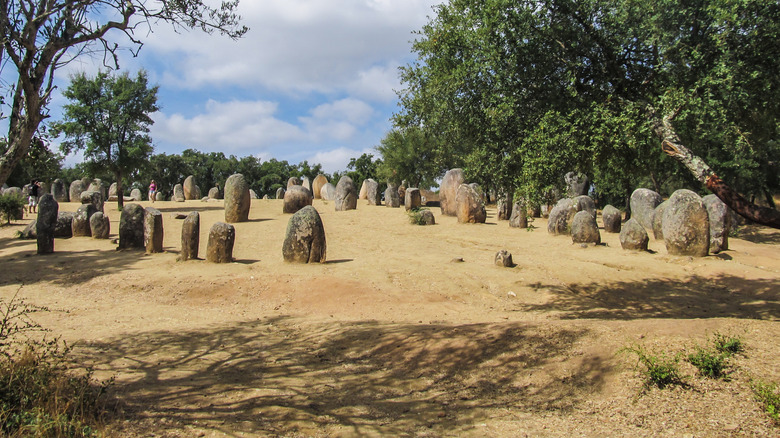What Are Portugal's Ancient Stone Circles?
In spite of the primitive connotation associated with prehistory, the Neolithic era (at times conflated with the "Stone Age") was in fact one full of mysterious yet complex cultures. While the specifics of their histories and beliefs are largely unknown to modern humans, proof for their existence is well documented, especially the large stone structures called megaliths that they erected (per ThoughtCo). One of the most well known of the these in Europe is Stonehenge, located 90 miles outside of London.
Stonehenge is what is classified as a cromlech — a ring of vertically-placed stones called menhirs. The circle of stones potentially had multiple religious and cultural functions, such as a pilgrimage and burial site (via Medieval Heritage).
In Evora, Portugal (pictured above) there is another cromlech known as the Almendres Cromlech. Predating Stonehenge, it is believed to have served functions similar to those of the British site and many of the other cromlechs found across mainland Europe (via The Travel).
Like many cromlechs, it was made to align with the sun, moon, and stars
First excavated in 1966, the Almendres Cromlech was built and added on to over the course of several centuries beginning around 5,000-4,000 B.C. Unlike the rectangular stones used in Stonehenge, those of Almendres (of which there are 95, though originally more were present) are mostly oval shaped, like an egg or nut, although other shapes are also present (per Visit Evora). The stones were not only found to have been arranged to be in line with the sun, moon, planets, and stars, but there is also evidence that they were adjusted, to improve the alignment (via Atlas Obscura). Several of the stones have designs carved into them. The stones range widely in size, up to nearly 15 feet tall, though most are much shorter.
As with every other cromlech, the exact purpose of their alignment with the equinox and solstice is not clear, as written language is not known to have existed anywhere prior to that of Sumerian, over 2,000 years after the cromlech began construction (via Britannica). It may have been used as a pilgrimage or festival site, as is speculated with Stonehenge, or the mere observation of star movement may have been the main goal — like a rudimentary observatory, as noted by Ancient Origins.

